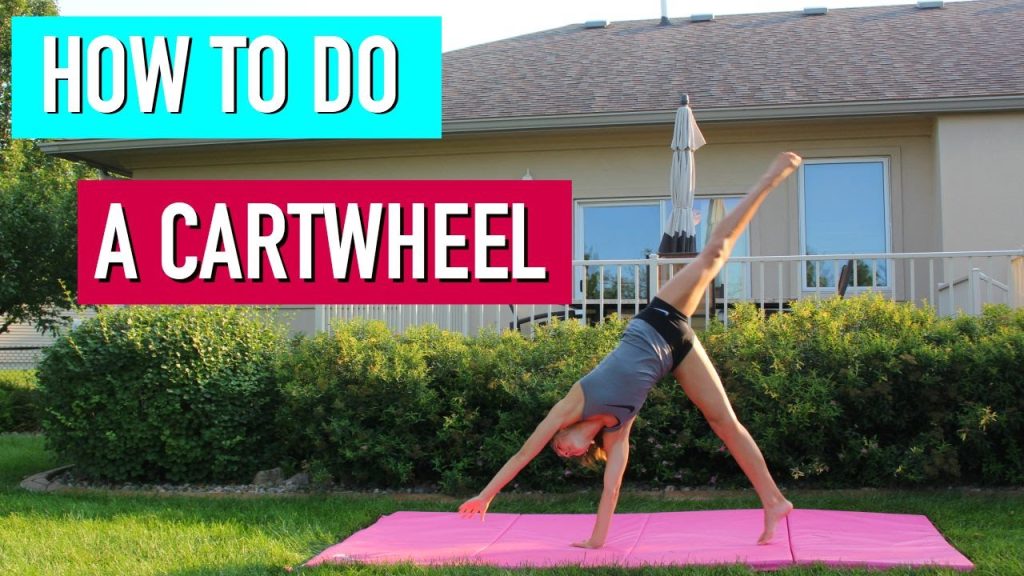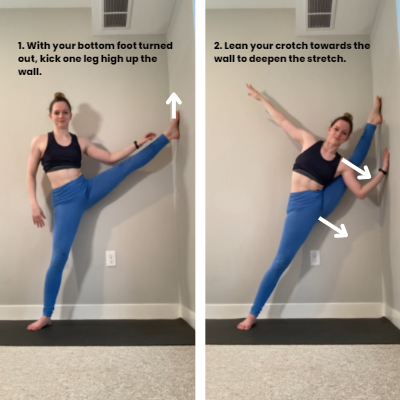Learning to do a cartwheel is an exciting part of gymnastics. It’s a fundamental skill that looks impressive and is fun to perform.
A cartwheel is a basic move that many gymnasts master early on. It helps build strength, balance, and coordination. For beginners, it might seem challenging, but with practice and the right technique, anyone can learn it. In this guide, we will break down the steps to performing a perfect cartwheel.
Whether you’re a beginner or looking to refine your skills, this tutorial will help you achieve your gymnastics goals. Let’s dive into the world of cartwheels and discover how you can perform this classic move with confidence and ease.
Introduction To Cartwheels
Cartwheels are a fundamental skill in gymnastics. They look graceful and are often the first trick beginners want to learn. Mastering a cartwheel builds a strong foundation for more advanced moves.
Basics Of A Cartwheel
Start with a wide stance. Place one foot in front of the other. Bend your knees slightly. Raise your arms overhead. Keep them straight and tight to your ears. Look forward.
Shift your weight onto your front leg. Kick your back leg up. Your body should follow in a fluid motion. Your hands touch the ground one at a time. Keep your arms straight. Your legs should be in a wide V shape.
As your legs pass over your body, shift weight to your hands. Land on your feet one at a time. Your body should end in a similar position to the start. Practice makes perfect.
Benefits Of Learning Cartwheels
Cartwheels build upper body strength. They also improve balance. Coordination skills enhance. Learning cartwheels boosts confidence.
Cartwheels are a fun way to stay active. They can be performed almost anywhere. Mastering them opens doors to more complex gymnastics skills.
Overall, cartwheels are an essential skill. They are both beneficial and enjoyable. Start practicing today!
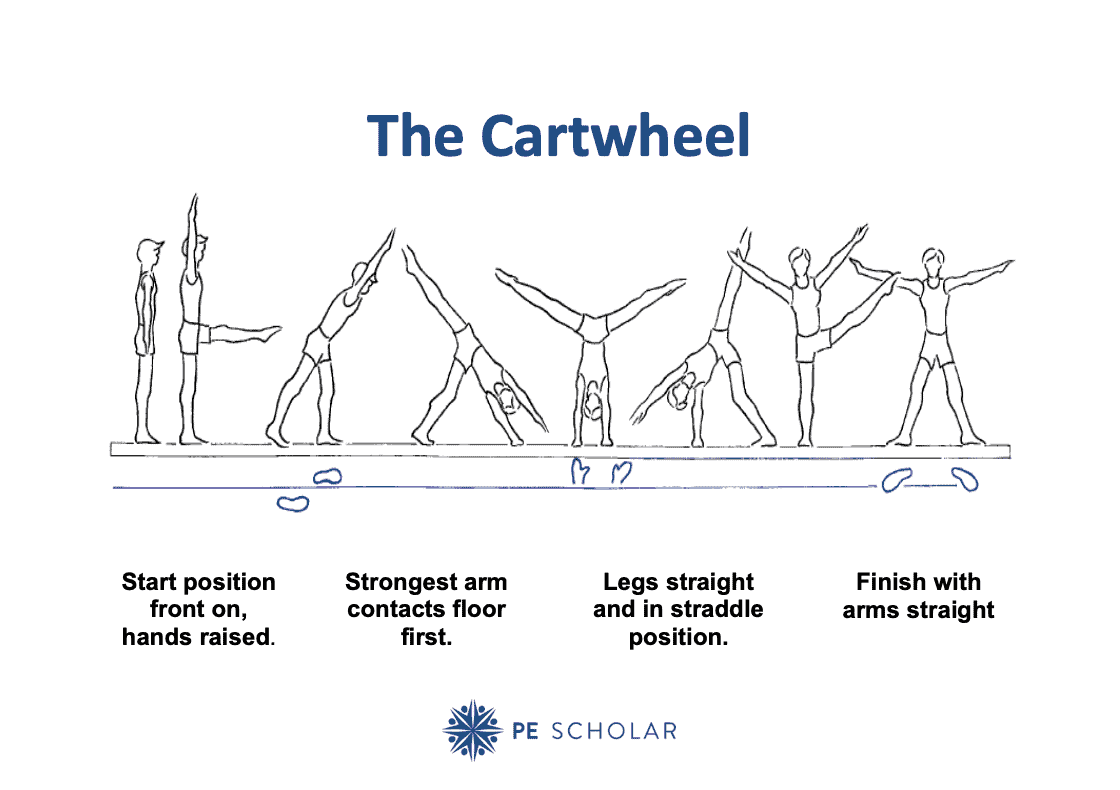
Credit: www.pescholar.com
Preparing For A Cartwheel
Preparing for a cartwheel is an essential step in mastering this gymnastics move. Proper preparation ensures safety and success. Focus on warming up your body and choosing the right space. These steps will set you up for a successful cartwheel.
Warm-up Exercises
Start with gentle stretches. Stretch your arms, legs, and back. This helps to loosen your muscles. Next, do some light cardio. Jog in place or do jumping jacks for five minutes. This increases your heart rate and warms your body. Perform arm circles to prepare your shoulders. Swing your arms forward and backward. Finish with wrist stretches. Hold each stretch for 15-20 seconds.
Choosing The Right Space
Select a spacious area. Ensure there is enough room to move. Avoid furniture and obstacles. A grassy field or gym mat works well. These surfaces provide a soft landing. Check the ground for any hazards. Make sure the surface is even and clean. This prevents injuries during your practice. Proper space is key to a safe cartwheel.
Body Positioning
Body positioning is crucial for performing a perfect cartwheel in gymnastics. Each part of your body must be in the right place at the right time. This ensures balance, control, and proper execution.
Starting Stance
Begin by standing tall with your feet together. Keep your arms straight and raised above your head. This will help you stay balanced.
Face forward and look straight ahead. Tighten your core muscles to maintain stability. Your weight should be evenly distributed on both feet.
Hand Placement
As you initiate the cartwheel, place your hands on the ground one at a time. The first hand should land directly in front of your leading foot.
Spread your fingers wide for better grip. The second hand should follow, landing parallel to the first hand. Keep your arms straight and strong.
Your hands act as the pivot point for the cartwheel. Proper hand placement helps maintain balance and control.
Executing The Cartwheel
Mastering the cartwheel in gymnastics requires precision and practice. This section will guide you through the essential steps of executing a flawless cartwheel. Focus on each phase to ensure a smooth and controlled movement.
Initial Movement
Start in a lunge position with your dominant leg in front. Keep your front knee bent and back leg straight. Your arms should be raised above your head, close to your ears. This stance provides the stability and momentum needed for the cartwheel.
Push off with your back leg while reaching your hands towards the ground. Keep your body tight and your eyes on the spot where your hands will land. This helps in maintaining balance and direction.
Mid-air Alignment
As your hands touch the ground, kick your back leg up. Your legs should be straight and spread apart, forming a wide V shape. Your body should be inverted, with your weight evenly distributed between your hands and legs.
Maintain a straight line from your hands to your feet. Engage your core muscles to keep your body aligned. This alignment is crucial for a smooth and controlled descent.
As you complete the cartwheel, bring your legs down one after the other. Land softly on your feet in a lunge position. Your arms should be raised above your head, mirroring the initial stance.
Practicing these steps will help you execute a perfect cartwheel. Remember to stay focused and maintain proper alignment throughout the movement.
Landing Safely
Landing safely is a crucial part of performing a cartwheel in gymnastics. Ensuring a proper landing helps prevent injuries and allows you to maintain your balance. This section will guide you through the essential aspects of landing safely, focusing on feet position and balancing techniques.
Feet Position
The position of your feet is key to a safe landing. As you complete your cartwheel, aim to land with both feet pointing forward. Keep them shoulder-width apart to provide a stable base. This helps distribute your weight evenly and prevents wobbling.
Bend your knees slightly to absorb the impact. This reduces the strain on your joints. Soft landings are safer and more controlled.
Balancing Techniques
Maintaining balance is essential for a safe landing. Focus on keeping your body aligned. Your head should be up, and your eyes should look straight ahead. This helps maintain your center of gravity.
Use your arms for balance. Extend them out to your sides if needed. This can help stabilize your landing. Practice makes perfect, so keep working on your balance.
Remember to engage your core muscles. This provides extra support and stability. A strong core helps you land more smoothly.
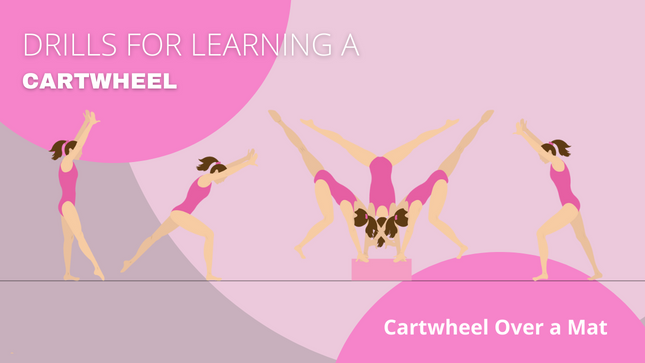
Credit: gymnasticshq.com
Common Mistakes
Learning to do a cartwheel can be challenging. Many beginners make mistakes that can hinder their progress. Understanding these common mistakes can help you improve faster and avoid injuries.
Incorrect Hand Placement
Proper hand placement is crucial for a successful cartwheel. Placing your hands too close together or too far apart can throw off your balance.
- Hands too close: This can cause you to fall to one side.
- Hands too far apart: This can lead to a lack of control.
Ensure your hands are shoulder-width apart. This provides a stable base for your cartwheel.
Improper Leg Alignment
Your legs play a key role in the cartwheel movement. Incorrect leg alignment can make your cartwheel look sloppy and unbalanced.
- Bent knees: Keep your legs straight to maintain form.
- Uneven legs: Both legs should be at the same height during the cartwheel.
Focus on keeping your legs straight and aligned. Practice in front of a mirror to check your form.
Practicing Consistently
Practicing consistently is the key to mastering the cartwheel in gymnastics. Regular practice builds muscle memory and improves technique. Consistency helps you overcome challenges and gain confidence. Let’s explore the daily routines and progress tracking methods to enhance your cartwheel practice.
Daily Routines
Establishing a daily routine is crucial for improvement. Here are some tips:
- Warm-up: Spend 10 minutes stretching.
- Drills: Practice basic drills like handstands and splits.
- Cartwheel Practice: Dedicate 15 minutes to cartwheel attempts.
- Cool Down: Finish with light stretching to prevent injury.
Progress Tracking
Tracking your progress helps you stay motivated. Consider these methods:
| Method | Description |
|---|---|
| Journal | Write down daily practice notes and improvements. |
| Video Recording | Record your cartwheels to see form and technique. |
| Feedback | Ask a coach or friend for feedback. |
Regularly reviewing your progress helps identify strengths and areas for improvement. This approach ensures steady and consistent progress.
Advanced Techniques
Once you’ve mastered the basic cartwheel, it’s time to explore advanced techniques. Advanced cartwheel variations challenge your balance, strength, and coordination. They also add flair to your gymnastics routine. Here, we will discuss two advanced techniques: one-handed cartwheels and aerial cartwheels.
One-handed Cartwheels
One-handed cartwheels require more strength and balance. Begin by practicing regular cartwheels to build confidence. As you get comfortable, try lifting one hand off the ground. Start with your dominant hand to make it easier. Keep your eyes on the ground for better balance.
Focus on maintaining a straight line with your body. This helps in keeping control. Practice regularly to build muscle memory. Gradually, you will perform one-handed cartwheels with ease.
Aerial Cartwheels
Aerial cartwheels take your skills to the next level. They are also known as no-handed cartwheels. Begin with strong leg muscles and good flexibility. Start by practicing high, powerful cartwheels. This builds the momentum needed for an aerial cartwheel.
As you progress, push off the ground with more force. Aim to lift both hands off the ground. Keep your body tight and straight. Your legs should follow a wide, circular path. Practice in a safe environment with soft mats. This reduces the risk of injury.
Remember, consistency is key. With regular practice, you can master aerial cartwheels. Stay patient and dedicated to your training.
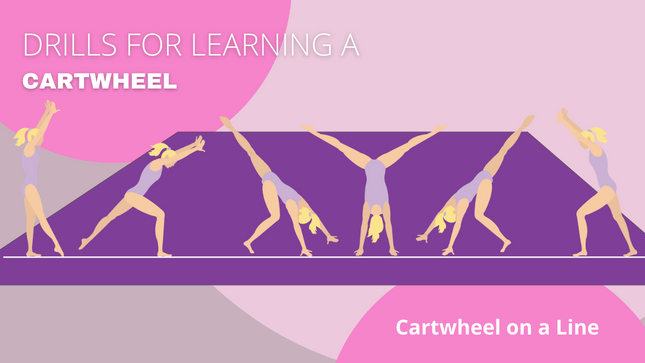
Credit: gymnasticshq.com
Frequently Asked Questions
What Is The First Step To Do A Cartwheel?
The first step is starting with a proper stance. Begin by standing straight with your arms raised above your head.
How Can I Improve My Cartwheel Balance?
To improve balance, practice holding a handstand position. Strong core muscles also help maintain stability during a cartwheel.
What Common Mistakes Should I Avoid?
Avoid these mistakes: incorrect hand placement, not fully extending legs, and failing to maintain a straight line throughout the movement.
How Long Does It Take To Learn A Cartwheel?
The time varies. With regular practice, beginners can typically learn a cartwheel in a few weeks.
Conclusion
Learning to do a cartwheel can be fun and rewarding. Practice each step carefully. Balance is key. Remember to keep your legs straight. Use your arms for support. Don’t rush the process. Patience and consistency lead to improvement. Celebrate small successes along the way.
Always warm up before practicing. Stay safe and listen to your body. Enjoy the journey of mastering this move. With time, your cartwheel will look amazing. Keep practicing and stay positive.

